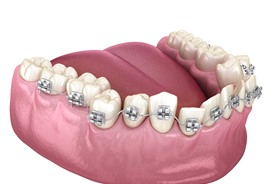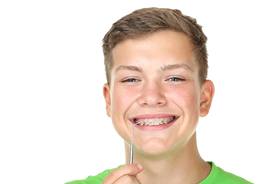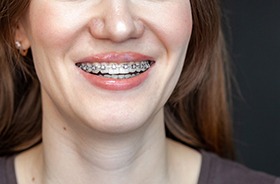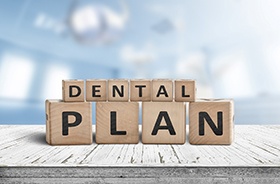
Traditional Braces – Torrington, CT
The Tried-and-True Route to Straighter Teeth

These days, there are multiple types of orthodontic treatments on the market. However, traditional braces are still extremely popular — and for good reason. This time-tested method for straightening teeth is suitable for almost any patient who wants to correct dental misalignment and improve their oral health. We are proud to offer this reliable, highly effective treatment. Read on below to learn more about traditional braces in Torrington and how they may be able to help you.
Why Choose Torrington Dental Care for Traditional Braces?
- Experienced On-staff Orthodontic Expert
- Friendly & Knowledgeable Team
- Flexible Payment Options
How Do Traditional Braces Work?

Dental misalignment can contribute to a range of other issues, including bad breath, dental decay, jaw pain, and more. Traditional braces help to correct that misalignment by applying consistent, gentle pressure to the teeth over a period of several months or even a few years. They consist of brackets, which get bonded to the teeth, and an arch wire that connects the brackets. As the wire gradually gets tightened every 6 – 8 weeks or so, the teeth shift into their proper positions.
What Orthodontic Issues Can Braces Fix?

As one of the most powerful orthodontic treatment options, braces can correct most types of dental misalignment. When you visit your dentist in Torrington for your consultation, they will assess the positioning of both your bite and your teeth before they recommend the best way to address any alignment problems.
Bite Misalignment
Overbite, underbite, crossbite, and open bite are all forms of malocclusion (misaligned bite). They can affect the aesthetics of your face and threaten your oral health. Braces, usually with the help of other accessories, such as elastics and perhaps even headgear, can address most cases of bite misalignment.
Crowded & Crooked Teeth
Crooked and crowded teeth do not have enough space between them to function properly. They might hit each other at odd angles, putting them at an increased risk of breakage. They can also trap food between them, heightening the chances of bad breath, gum disease, and tooth decay. Braces, perhaps after extractions, can usually ensure that every tooth has the space it needs to thrive.
Gapped Teeth
Large gaps between the teeth can leave your gums vulnerable to harm. Plus, many people do not like the aesthetic consequences of extra space in their smile. Braces can move the teeth close together, thereby helping to protect your gums while enhancing your appearance.
Caring for Your Braces

Once you get used to caring for braces, it may become a natural part of your routine. Here are a few tips to help you out:
- Maintain excellent oral hygiene. You may need special tools, like a water flosser or floss threader, to clean around your brackets and wires.
- Adjust your eating habits. Extremely sticky foods, hard foods, and foods with small pieces (like popcorn) are best avoided while you have braces.
- Attend all recommended appointments. Our team will track your treatment’s progress and support you if you run into any unexpected problems.
Understanding the Cost of Traditional Braces

The cost of traditional braces in Torrington varies from case to case. Several factors can affect the price of treatment. During your consultation, our team will be able to provide you with a cost estimate. We will also assist you as you explore payment options, such as insurance and financing.
Factors That Affect the Cost of Traditional Braces

Some factors that can influence the cost of braces include:
- The severity and complexity of your case. More complex cases take more time to correct, require more appointments, and may necessitate the use of special accessories. Additional treatments, such as extractions, might also be recommended. All such factors can increase the total cost of braces.
- Your age. Bone remodeling tends to slow down with age. Hence, adult teeth take longer to move than those of younger individuals. This can lead to slightly lengthier treatment times and increased fees.
- Compliance with treatment guidelines. It is important that you follow all treatment instructions. Failure to do so could delay your final results and lead to the need for additional appointments, which, of course, is likely increase your total cost.
Professional Braces vs. DIY Braces: Comparing Your Options

You might have heard of some so-called “hacks” for moving teeth without professional treatment. For example, some people advocate the use of things like paperclips, dental floss, and superglue to create makeshift braces at home. While such methods might seem like a tempting way to save money, extreme caution is in order.
Many people who have tried to move their teeth without professional help have ended up damaging their smile. They frequently pay more than they would if they had visited a dentist right from the beginning. Professional treatment is the safest, and often the most cost-effective, way to straighten teeth.
Does Dental Insurance Cover Braces?

Dental insurance policies vary greatly in how they handle braces. Some policies only cover orthodontia for minors, whereas other policies do not cover braces at all. A few premium plans cover up to half the price of braces (for both adults and children). If you have such a plan, it may reduce your out of pocket costs by hundreds of dollars — perhaps a thousand dollars or more.
If your insurance does not cover braces, you might try using your flexible spending account or healthcare savings account to pay for them instead.
Options for Making Braces Affordable

Our team is ready to help you navigate your insurance benefits. We also offer additional provisions that may help you afford treatment:
- Most patients qualify for a low-interest monthly payment plan through CareCredit. The application process is fast, and you may be able to choose between several monthly payment amounts.
- We periodically offer promotional pricing on braces. Contact us to learn about our current specials.
Our team is ready to help you straighten your teeth and understand the financial aspect of your treatment. Get in touch with us today to schedule your consultation.
Traditional Braces FAQs

The skilled, experienced team at Torrington Dental Care will be happy to answer your questions about braces in Torrington when you visit us for your first orthodontic appointment. In the meantime, however, you may want to do a little information-gathering on your own. To help you out, we have put together the following list of frequently asked questions about braces. Make a note of anything you would like further explanation on — we will be happy to personally address all of your concerns.
Am I Too Old to Get Braces?
Traditional metal braces are often associated with children and teenagers. However, there is no upper age limit for this treatment; in fact, roughly one out of every four orthodontic patients is an adult!
Treatment for adults and children is the same in many ways. However, there are some minor differences. For example, older individuals tend to have harder, less malleable bones, which means that it may take slightly longer for your teeth to move into their proper positions. Also, keep in mind that while some dental insurance policies cover braces for minors, coverage is less common for adult cases. Our team can help you explore options if you are concerned about paying for braces. For example, you might be eligible for low-interest financing.
What Happens After You Get Your Braces Off?
Teeth have a sort of “memory,” meaning that they are likely to drift back into their original positions after braces are removed. To prevent this issue, you will need to wear a retainer. If your retainer is removable, you will have to wear it 20 – 22 hours every day during the initial period after your braces are taken off. Later, though, you may be able to transition to wearing it only at night. If you are eligible for a fixed retainer, it will be bonded onto your teeth, so you will not have to remember to wear it.
How Long Do Traditional Braces Take?
During your consultation, we will be able to estimate how long it will take for braces to finish their job. The average treatment time is 1 – 3 years. Exactly how long you will have to wear braces depends largely on the extent of your dental misalignment. Other factors, such as your age and your compliance with treatment guidelines, may also have a bearing on how long your treatment takes.
Do Traditional Braces Hurt?
Modern braces are more comfortable than those of past generations. However, some soreness is still to be expected; after all, the braces are applying continuous pressure to the teeth. The discomfort is likely to be greatest immediately after your braces are adjusted.
You can cope with braces-related soreness by taking pain relievers and sipping on cool water. If the metal parts of your braces are irritating you, you might find it helpful to apply orthodontic wax to them. Any severe or persistent pain merits a phone call to our office.